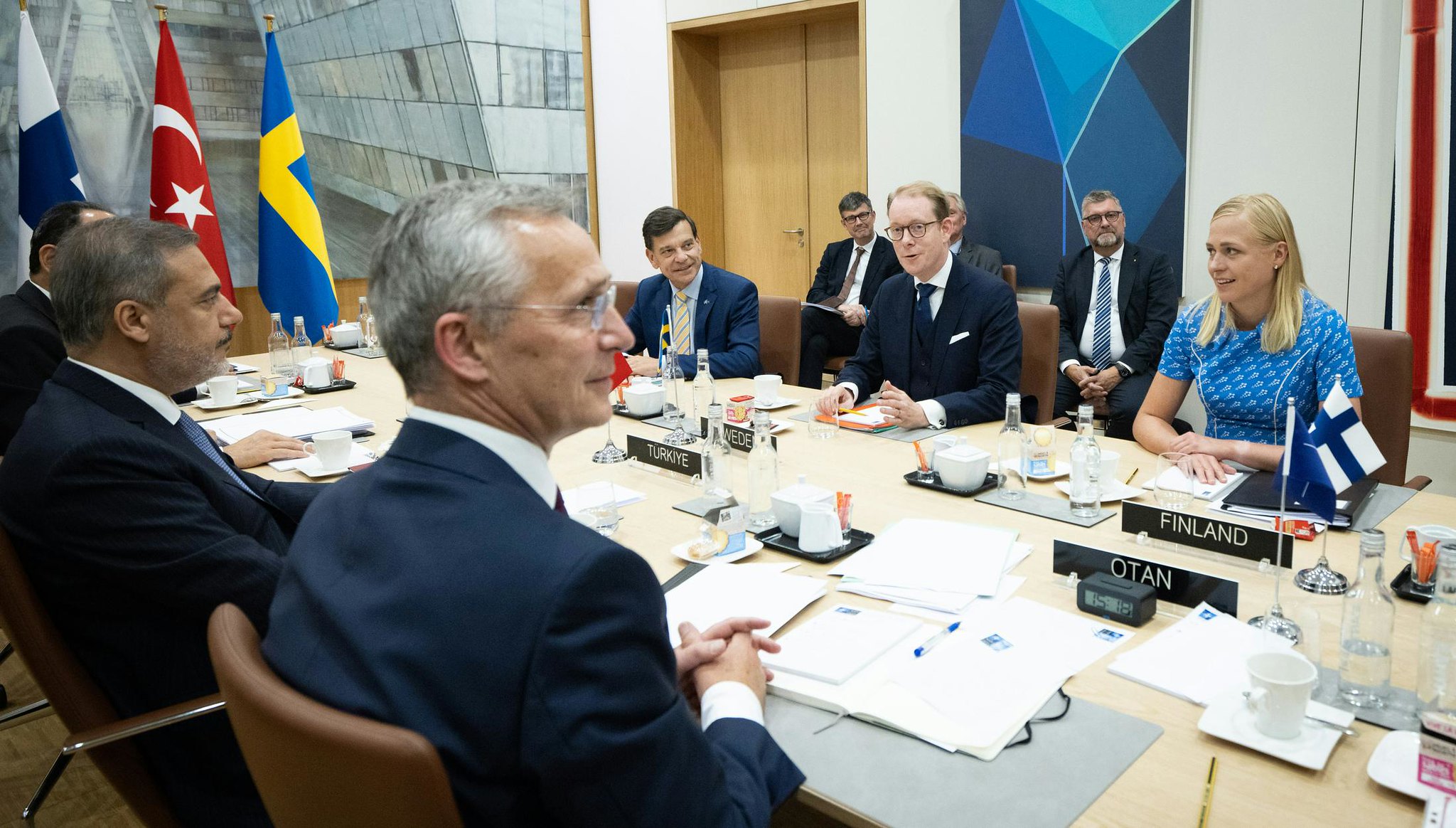by ANA STEVANOVIĆ ĐUKIĆ
Although the Russian attack on Georgia in 2008 raised concerns in some Central and Eastern European countries, it wasn’t until 2014 and the annexation of Crimea that most European Union and NATO members considered Russia a major security threat and the primary challenge to security among the Nordic countries (Saxi 2019). The Ukrainian crisis led to the explicit identification of Russia as a threat source, triggering a successful collective (re)securitization by NATO (Sperling and Webber 2017). Scazzieri (2022) emphasizes that Putin’s attack on Ukraine marks the beginning of a more dangerous era for European security, where European leaders must overcome their divisions and strengthen their defense, both through the EU and NATO. Therefore, the beginning of the war represents a turning point in European security as it also raises the question of the further implications of its full-scale escalation.
The two countries particularly affected by this conflict are the Kingdom of Sweden and the Republic of Finland, given that both countries, amid their geographical proximity, have had a long and rather complicated relationship with Russia for centuries. This relationship significantly influenced, conditioned and shaped their security and foreign policies for decades after the Second World War and during the period of the Cold War. Until the war in Ukraine, Sweden and Finland were the only EU members sharing borders with Russia that adhered to their tradition of neutrality and non-alignment with military alliances. Most political parties in the region supported neutrality, and the public opinion polls showed that the percentage of support for potential NATO membership was in the minority (Simons et al. 2019). By not being NATO members, it meant in reality that if Russia decided to attack either of these two countries, NATO members had no formal obligation to deploy their forces to provide protection.
After Russia’s invasion of Ukraine in February 2022, the dominant narratives among relevant domestic political actors regarding the possibility of NATO membership significantly and fundamentally shifted. This change signifies the beginning of an entirely different direction of the course in the foreign and defense policies of Finland and Sweden. The aim of this text is to, drawing on the securitization theory, illustrate the process of Finland and Sweden’s accession to NATO after the beginning of the conflict in Ukraine.
Speaking of Sweden, since the end of the Cold War and its accession to the European Union, the potential NATO membership for this country has been a controversial issue both at the political level and within the local public opinion (Möller and Bjereld 2010, 371). The reason for this can be found in the deeply rooted tradition of neutrality in the country’s political system, as well as in its foreign policy where neutrality sovereignly held a central position due to the belief that this tradition kept Sweden out of potential conflicts. In Finland’s case, Forsberg (2023a) reminds us that, considering the shared land border of over 1,300 kilometers, the national interest of this country has long been seen in preserving good relations with the Kremlin to avoid a major conflict. Russia’s military invasion of Ukraine, however, reaffirmed the importance of NATO, ‘refreshing’ the alliance and reinforcing its role as a provider of robust security.
Arter (2023) reminds that until February 24, 2022, a clear majority of politicians and Finnish citizens were against NATO membership and that Putin’s ‘special military operation’ in Ukraine triggered a sense of fear psychosis among the Finnish public, awakening collective memories of territorial loss, lives, and existence due to Soviet aggression in the Winter War of 1939-1940, and fear of history repeating itself at various points of tension in Finnish-Soviet relations. In the literature from the Cold War era, Finland’s status is explained through the concept of finlandization, a term that implies neutrality not entirely based on conducting independent foreign policy. During the Cold War, Finland avoided unnecessary provocation of the USSR in international forums, often offering moderate support for certain decisions and actions of the USSR in foreign policy. Finland chose a path of remaining neutral to preserve its independence by maintaining good relations with both the East and the West. Finland refused to join the Eastern Bloc but identified with the West through trade and culture. The Finnish approach involved providing security to the USSR, which, in return, could expect predictability with strict adherence to expected Finnish foreign and security policies, including Finland’s recognition of Soviet “legitimate” security interests. Bearing this in mind that certain phenomena can be successfully securitized if specific threatening associations are already linked to them (Ejdus 2016, 206), it is understandable to conclude that securitizing the war in Ukraine was easier in Finland than in Sweden, given the very vivid memories of previous challenges in Finnish-Russian relations.
The securitization process is typically carried out by political elites, who use language, rhetoric, or political instruments to mobilize support for urgent and special measures that go beyond regular political procedures. It provides the opportunity to conceptualize security as a speech act. Therefore, in January 2022, the public debate on NATO in Finland intensified after Russia presented draft agreements between the U.S. and NATO regarding ‘security guarantees,’ demanding that NATO no longer accept new members (Reuters 2022). In the same month, just a few weeks before the attack, Prime Minister Sanna Marin stated in an interview that NATO membership was ‘very unlikely’ during her current term (Reuters 2022). The Prime Minister expressed the belief that Finland did not plan to join NATO in the near future, a statement made when only 28 percent of Finns supported NATO membership. It’s interesting that during February 2022, Finnish President Sauli Niinistö didn’t believe that swift decisions regarding Finland’s NATO membership were even an option, primarily due to the justified fear that it could destabilize the security situation in Northern Europe and provoke potential countermeasures or reactions from Russia, including reducing the chances of an early ceasefire in Ukraine (YLE 2022).
Throughout his entire term, Finnish President Niinistö emphasized that he couldn’t lead Finland into NATO if the people were against it. However, observing rapid shifts in public opinion in favor of joining, he decided to initiate a process that would lead to the application for membership. By early March, Niinistö began a series of political and diplomatic discussions with Washington and other key NATO actors to prepare for the formal decision to apply for membership. Of particular importance was that both countries, Finland and Sweden, initiated this process simultaneously (Forsberg 2023b).
It is useful to recall that the essential conditions for successful securitization are context-dependent, audience-oriented, and involve a power-laden process dynamic (Balzacq 2005, 179). The likelihood of successful securitization increases during critical times because the audience is more willing to respond to securitizing moves, especially if securitizing actors effectively connect them to the context in which securitization takes place (Balzacq 2005, 182). Therefore, although the idea of joining NATO had not garnered significant support within Finnish and Swedish public opinion for decades, a dramatic shift in attitudes occurred precisely after the Russian attack on Ukraine. Assessments and a rapid increase in public support for NATO membership were accompanied by discourses and narratives of local political leaders, starting from initially excluding the possibility of NATO membership, moving towards acceptance of that option, emphasizing a high likelihood, all the way to constructing narratives that NATO membership is the best option for ensuring the security of these countries. The critical time was present, the context of a significant threat was established, and the public, as indicated in opinion polls, overwhelmingly expressed a desire for appropriate action. It can be concluded that all elements of successful securitization were met.
It can be concluded that the security response, in this case, the Finland’s and Sweden’s request for NATO membership, is proportionate to the existing threat as it represents an appropriate measure in proportion to the assumed threat by Russia. Even the presence of the most securitizing actors in Sweden and Finland with the social capital and credibility to speak on security suggests a significant level of serious threat to their security, potentially justifying swift action and their NATO membership.
References
Arter, David. 2023. “From Finlandisation and post-Finlandisation to the end of Finlandisation? Finland’s road to a NATO application.” European Security 32 (2): 171–189.
Balzacq, Thierry. 2005. “The three faces of securitization: Political agency, audience and context.” European Journal of International Relations 11 (2): 171–201.
Ejdus, Filip. 2016. Diskurzivna i praktična konstrukcija međunarodne (ne) bezbednosti. Konstruktivističke teorije međunarodnih odnosa, 199–227.
Forsberg, Tuomas. 2023a. Finland and Sweden’s Road to NATO. Current History 122 (842): 89–94.
Forsberg, Tuomas. 2023b. Four rounds of the Finnish NATO debate. Nordic Review of International Studies 1 (1): 41–50.
Möller, Ulrika, and Ulf Bjereld. 2010. “From Nordic neutrals to post-neutral Europeans: Differences in Finnish and Swedish policy transformation.” Cooperation and Conflict 45 (4): 363–386.
Saxi, Håkon Lunde. 2019. “The rise, fall and resurgence of Nordic defence cooperation.” International Affairs 95 (3): 659–680.
Scazzieri, Luigi. 2022. “Russia’s assault on Ukraine and European security.” Centre for European Reform, March, 30, 2022.
Simons, Greg, Andrey Manoylo, and Philipp Trunov. 2019. “Sweden and the NATO debate: views from Sweden and Russia.” Global Affairs 5 (4-5): 335–345.
Sperling, James, and Mark Webber, M. 2017. “NATO and the Ukraine crisis: Collective securitisation.” European Journal of International Security 2 (1): 19–46.
*This blogpost is based on the research that the author has done in her MA thesis titled The theory of securitization and Finland’s and Sweden’s NATO accession, defended at the University of Belgrade, Faculty of Political Science in September 2023.
Ana Stevanović Đukić is born in Belgrade in 1984. In 2008 she graduated at the Faculty of Dramatic Arts in Belgrade. In 2015, she defended her doctoral thesis, investigating creativity in leadership and management in cultural institutions, earning the title of Doctor of Arts and Media. In September 2023, she gained the MA diploma at the Faculty of Political Sciences in Belgrade, specializing in international security, and received an OSCE scholarship for these studies.
For several years, she was professor of production in culture and media, cultural studies, art history, and public relations, and very briefly lectured at an art college, holding the position of assistant professor.
Seeking to contribute to societal change and believing in the power of knowledge and education, she became politically active and was elected as a Member of Parliament in the National Assembly of the Republic of Serbia in 2016. As an MP, she was one of the most active members, advocating for improvements in local media, consistently highlighting legal violations and abuses in the media. She collaborated with numerous NGOs, striving to make parliamentary work more transparent and accessible, aiming to be a true voice for citizens in the Parliament.
She served as the deputy leader of the parliamentary group, a member of the parliamentary delegation to the Council of Europe, and part of several parliamentary committees, notably the Committee on Culture and Information. Due to a significant shift in the party’s policies in 2018, she resigned from her position as vice president.
Over the past decade, she honed her skills in Greece, the United States, Poland, and Sweden, attending various professional and educational programs organized by prestigious international organizations and universities.
In 2017, she was selected by the United States Embassy in Belgrade to participate in the Open World leadership program. A year later, she received a scholarship from the Swedish Institute and pursued studies at Malmo University in Sweden.
In 2019, she was invited to enhance her skills at the prestigious College of Europe in Natolin (Poland) through the WEASA program. In 2020, she was selected to participate in the Annual Seminar, a leadership and educational program by the Belgrade Fund for Political Excellence and the School of Political Studies within the Council of Europe. In 2022, she was chosen by the Diplomatic Academy in Vienna to attend a program designed for civil servants and young diplomats from Southeastern Europe.
Photo credit: NATO Secretary General Jens Stoltenberg meets with the Minister of Foreign Affairs of Türkiye, Hakan Fidan, the Minister of Foreign Affairs of Sweden, Tobias Billström and the Minister of Foreign Affairs of Finland, Elina Valtonen. NATO Flickr.







